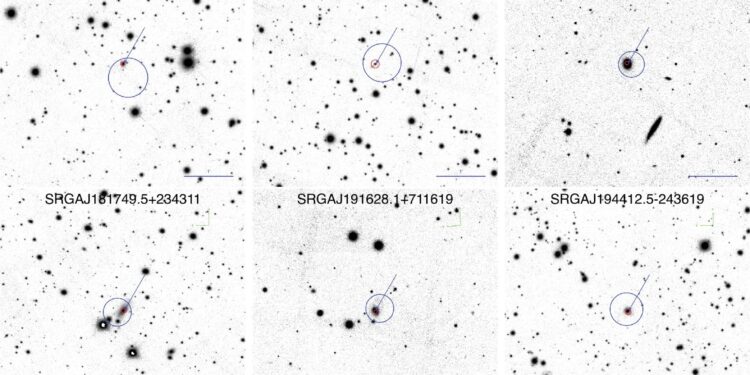Optical images of X -ray sources studied in the R filter from the PSS1 PS1 survey. Credit: Astronomy letters (2024). DOI: 10.1134 / S106377372470018X
Using the Spektr-RG space observatory (SRG), astronomers from the Russian Academy of Sciences have studied dozens of X-ray sources in all-cella investigations, which led to the detection of 11 new active galactic nuclei. The result was reported in a research document published in Astronomy letters.
The active galactic nuclei (AGN) are small regions in the center of a galaxy dominated by the light emitted by dust and gas. They are brighter than the light of the surrounding galaxy and also very energetic due to the presence of a black hole or a star formation activity in the heart of the galaxy. In general, AGNs are the luminous persistent sources of electromagnetic radiation in the universe.
A group of astronomers led by Grigory Uskov leads an inspection of X-ray sources discovered with the SRG Art-XC telescope and also known X-ray sources whose nature remains unknown. So far, their studies have led to the identification of more than 50 AGNs and several cataclysmic variables. Now they report their latest conclusions.
“In this article, we present the results of our optical identification and our classification of 11 other AGNs in the Artss1-5 catalog”, wrote the researchers.
The 11 newly found AGNs have proven to be relatively nearby, to red offsets of 0.028-0.258. The x -ray luminosities of these sources are located in the range of 2 to 300 Erg Tredecillion, therefore typical for the AGN in the present time.
Based on the data collected, astronomers have classified the 11 AGN galaxies as Seyfert galaxies – seven types 1 (SY 1), three types 1.9 (SY 1.9) and a type 2 (SY 2). In general, Seyfert galaxies are the most common active galaxies. Although they look like normal galaxies in visible light, they emit considerable infrared radiation, with large optical emission lines, the latter with narrower emission lines. Observations show that Sy 1 galaxies have large optical emission lines, while those of Sy 2 type present narrower emission lines.
The researchers also calculated the masses of black holes of the seven Seyfert galaxies reported in the document. It has been found that their masses are between 4.68 and 150 million solar masses.
According to the study, the spectrum of one of the new AGNs, appointed SRGA J000132.9 + 240237, is described by a power law with a slope of less than 0.5, which suggests a strong absorption and a significant contribution of reflected radiation from the dusty torus of the galaxy. The authors of the article noted that longer X -ray observations are necessary to determine the physical properties of this AGN.
“We plan to take a better quality X-ray spectrum from this source in pointing mode with the SRG / XC art-to-study telescope to study its physical properties in detail,” wrote scientists.
More information:
GS USKOV et al, new active galactic nuclei detected by art-XC and EROPOSTA telescopes during the first five SRG All-Sky X-rays. Part 2, Astronomy letters (2024). DOI: 10.1134 / S106377372470018X. On arxiv: DOI: 10.48550 / Arxiv. 2005.00109
Newspaper information:
arxiv
© 2025 Science X Network
Quote: Astronomers detect eleven new active galactic nuclei (2025, May 13) recovered on May 13, 2025 from
This document is subject to copyright. In addition to any fair program for private or research purposes, no part can be reproduced without written authorization. The content is provided only for information purposes.



